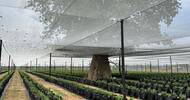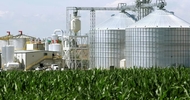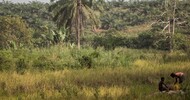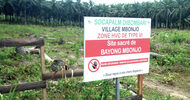
“If you look around the world and ask where you can put your money into defensive, secure land assets with exposure to a good operating environment and where, on a risk-weighted basis, returns look reasonable, you actually come down to a very narrow sub-set of the universe,” says Elizabeth O’Leary, head of agriculture at Macquarie Infrastructure and Real Assets (MIRA). “Australia sits within this sub-set.”
Agriculture: Germ of an asset class
by FLORENCE CHONG
Although institutional investment in agriculture remains minimal, this could change with structural shifts on the horizon. Florence Chong reports
According to asset managers, a window is emerging for institutional money to flow into agriculture due to change of ownership, notably in markets such as Australia and the US.
“In the next five years, around 4m acres of farmland a year will be traded in the US, partly driven by generational transfer of assets,” says Martin Davies, CEO of Westchester, the global agriculture arm of Nuveen. “People that have inherited land don’t want to farm it.”
Davies, who overseas a company with possibly the world’s largest institutional portfolio of farmland assets, says: “There will also be significant consolidation in the sector. Farmers will expand by leasing land rather than owning it and burdening their balance sheet. They are investing in the operating business with technology that will be necessary to drive improvements in efficiency of production.”
Elizabeth O’Leary, head of agriculture at Macquarie Infrastructure and Real Assets (MIRA), which manages more than A$2bn (€1.2bn) of agriculture assets in Australia and Brazil, says: “We continue to see demographic shifts where there is a flow of retiring farmers looking for good custodians, neighbours or corporates to acquire their farms. This creates opportunity for institutional capital to enter the sector.”
This window of opportunity is not lost on specialised agriculture fund managers. New funds have been launched or are being planned.
In January, private equity firm ADM Capital Europe held the final close of its Cibus Fund, which raised US$450m (€398m), including US$130m in co-investments.
Another London firm, Stafford Capital, is looking for equity for its new A$200m Stafford Australian Agricultural Real Estate Fund (SAAFII) to invest in farms in western and eastern Australia.
A large global fund manager is understood to be about to hold its first close for a substantial fund with a diversified agricultural portfolio.
Sam Sicilia, CIO of Australian superannuation fund Hostplus, has started talking to his peers about creating a fund to aggregate capital to invest in the sector. It is only the germ of an idea today, but Hostplus estimates that, for such a fund to work effectively, it should eventually have a A$20bn capital base.
The Industry Super Association says the sector has attracted a miniscule 0.2% of its members’ funds. First State Super and VicSuper stand out among their peers for being active.
Agriculture, then, is an enigma. Although barely an emerging investment option for all but a few institutions, it consistently outperforms other asset classes (see table over page). The level of institutional investment in US farmland is estimated at less than 2% of the entire US$2.5trn market.
According to the Australian Bureau of Statistics, the estimated proportion of agricultural land with at least 20% foreign interest was 13.4% in 2018. That figure remained relatively stable over the past three years at between 13.4% and 13.6%
Proponents see investment in agriculture as an inflation hedge because it has no correlation to economic cycles that affect other asset classes. Its deterrents include a lack of understanding the problem of achieving scale in a fragmented, often family-owned sector.
“When considering the maturity of the asset class, farmland is where timberland was 10 or 15 years ago and where real estate was probably 30 years ago,” says Davies.
Agriculture has traditionally been the preserve of larger pension funds and sovereign wealth funds, but Davies has observed that over the past five or six years Westchester has started to see tier-two and tier-three investors in its funds.
The company has US$8.2bn in assets under management, encompassing 500 properties extending to 2m acres of permanent and row crops across seven countries. Davies says farmland has generated consistent returns. Between 1966 and 2016, US Department of Agriculture records show that the total return from US farmland annually averaged 11%, with 5% from cash and 6% from capital growth.
Farmland has yielded better than 10-year US treasury bonds, he says, and there is “the optionality of capital growth upside as well”.
Davies adds: “A consistent theme through the last 15 years is the inflation hedge characteristics of farmland. Farmland is producing food and fibre, the necessities of life. That brings an elasticity of demand and no correlation with economic cycles. Farmland offers portfolio diversification. If you compare it to other real assets, the return volatility of farmland has been much lower.”
O’Leary says investment in agriculture is coming into its own because farmland is a finite asset. “In broadacre farms, land can make up 70% to 80% of your capital base, making it a defensive, stable non-correlated asset,” she says.
The world’s population is projected to reach 9.7bn by 2050, and arable land continues to give way to urbanisation across the world. “In the US, people talk about three acres of farmland per minute disappearing into urban development,” says Davies. “Over the past 20 years, farmland equating to the size of the productive land area of Iowa has been lost.”
O’Leary adds: “That population is growing is obvious. We need to continue to produce low-cost bulk commodities to feed a growing world. The other end of the barbell is the choosey customer who is increasingly health-conscious. These customers increasingly want to know what is in the packaging, how it is produced, where it is produced and who processes, and they make their buying decision on that set of information.
“So you have two worlds. Bulk grains going into protein demand and specialised demand like avocado, nuts, and organic foods for the health-conscious consumer.”
Davies says that, between 2013 and 2016, the number of avocados imported into Europe tripled. Blueberry consumption in the UK grew 10-fold from 2005 to 2016, although UK consumption of blueberries is still 40% lower than in the US.
Parts of the world, including California, Chile and Peru, have seen significant growth in production of permanent crops – tree nuts, avocados, blueberries, citrus, and table grapes – to meet the massive demand growth.
Ontario Teachers Pension Plan is one investor keen on both avocado farms and nut plantations. Last year it bought Australia’s second-largest avocado farm for A$180m. It also joined the US-based Renewable Resources Group to buy almost 3,000 hectares of almond plantation for about US$115m.
Last year, ADM Capital’s Cibus Fund bought a 400 hectare almond orchard in the Australian state of Victoria for its planned A$600m portfolio of mid-market investments, primarily in Europe and Australia.
There is the organic bent as well. US consumption of organic apples, for example, is growing rapidly.
Sowing diversification
Agriculture can be an inherently risky business, and diversification is the key to smooth out returns. Davies says diversification in geographical location, and by regions in a country, along with diversification in selection of crops, help to reduce weather and crop disease risks inherent in agriculture.
O’Leary says: “The key conversation I have with our investors is that this is a long-term investment. It is not a five-year, not even an eight-year investment. Our recent propositions to investors have been an investment period of 15 years or open-ended funds.”
MIRA runs three unlisted funds that have established three large agribusinesses: Paraway Pastoral Company, Lawson Grains, and Viridis Agriculture. Collectively, MIRA owns around 4.4m hectares in red meat primary production and about 150,000 hectares of cropping land in Australia and Brazil. Viridis also owns 700 hectares of permanent cropping land in partnership with leading Australia grower, Costa.
In Brazil, MIRA also crops some 50,000-55,000 hectares per annum that grow soya bean and corn. The difference between Brazil and Australia is that Brazilian farms are typically very large, newer farms with infrastructure footprints.
“Operating in this sector you deal with some knowns and some unknowns,” she says. The knowns are the science of agronomy and growing demand for food. “The unknowns are how mother nature is going to behave each production season, and that is always connected with the response of the global commodity market. This is particularly relevant in Australia, given that almost every commodity produced in Australia, is exported.“
O’Leary adds: “As an investor in agriculture, it is prudent to allow yourself the opportunity to ride through a couple of commodity cycles in order to benefit not only the cycles themselves but the following impact on the value of your land. We counsel investors to understand where the volatility and risk lie in their portfolio, how to mitigate it, and to recognise that some volatility is natural.”
Referring to the Macquarie Pastoral Fund, which established Paraway Pastoral Company Limited in 2007, she says: “We have real-world experience with our older portfolio, where some years returns are flat and others are in the teens. In the early days of the fund it went through a very challenging period for livestock in Australia. We had the drought in Queensland and a ban on live exports. So, of course, you had a period there of very suppressed returns, in contrast to the last five years when we saw double-digit returns.”
MIRA acquired more than 100,000 hectares of livestock and cropping properties in four Australian states for about A$300m in 2017 from the Qatar Investment Authority’s agricultural investment arm, Hassad Australia.
“If you look around the world and ask where you can put your money into defensive, secure land assets with exposure to a good operating environment and where, on a risk-weighted basis, returns look reasonable, you actually come down to a very narrow sub-set of the universe,” says O’Leary. “Australia sits within this sub-set.”
O’Leary says investors will look at everything from transparency around land ownership to sovereign risk. “They also look at the degree of government intervention and or support for the sector, the degree of talent expertise in the sector, and what sort of growing demand this host country gives exposure to,” she says.
There were very few wineries in the UK 10 to 15 years ago. Today, certain parts of the South Downs grow grapes that produce sparkling wines with characteristics like French champagne.
Davies says: “With increasing average temperature, more regions in the UK will become suitable for growing grapes in future.”
The UK experience bears witness that some regions and countries will suffer as a result of climate change, while others will benefit. “We take the view that, if you have diversification, you have an in-built hedge against climate change,” Davies says, adding that over 30 different crops are grown on land Westchester manages in a range of climatic locations with different growing seasons.
Davies refers to research by the University of Leeds which shows that the cropping zone in the Boreal region has the potential to move 1,200km further north than it currently is. “At the moment only 32% of that region has sufficient ‘growing degree days’ to produce crops. So you could take the view that in northern Europe, and the northern Baltic states – Latvia, Estonia Lithuania and northern Poland – you can grow a wider range of crops than you used to.”
O’Leary says that, over the past five years, there has been a growing awareness of the need to demonstrate a really robust ESG management regime and a drive towards limiting impact on the environment. “I would say we are moving into the next era of thinking, whereby progressive investors can do better than carbon neutrality.”
“This sector can actually sit at the forefront of carbon emissions reduction through the adoption of new technologies, new farming techniques and conservation that sit comfortably in agriculture. Good farming, good sustainability and biodiversity go hand in glove.”
She points to collaboration with research agencies, particularly the Australian government-owned CSIRO, to help farmers understand just how complementary biodiversity and soil health is for strong farm productivity.
Cattle have been blamed for contributing to global warming because of methane, a greenhouse gas, like carbon dioxide. “You can only counter with actions and not words and emotions,” O’Leary says. “We are pursuing emission efficiency and reduction across our portfolios.”
There is a two-pronged approach to tackle the problem with better cattle selection, breeding and genetics to produce cattle with better feed conversion so that they produce less methane gas. The second approach is to reduce the number of animals by increasing the kilograms of beef produced. The quality of pasture and pasture management will also make a difference.
O’Leary says there is a strong focus on soil health and soil productivity, and that this is relevant to cropping and livestock. “In our cropping portfolio, significant capital investment is being made in fixing the soil and restoring nutrient. We roll out best in class technology and farm practices to build up organic soil carbon – to create healthy soil.”
Farming is adopting increasingly sophisticated use of data to drive management decisions and to focus on the metrics of the business. The objective is to create scalable, diversified sustainable production assets that are better able to ride volatility in climatic cycles. Increasingly, farmers will be able to respond to change and even better able to reverse the negative impact on farming assets in the future, O’Leary says.
PSP Investments
Australia is fertile ground for PSP when it comes to its agricultural portfolio
Canadian pension fund PSP Investments has about 4% of its C$168bn (€112bn) assets invested in natural resources. Agriculture makes up 50.9% of its C$6.8bn natural resources portfolio, with 40.9% in timber and the remainder represented mainly by oil and gas investments.
Recently, PSP has featured prominently in transactions ranging from dairy properties to dryland farms, cattle properties, tree nut orchards, and cotton farms in Australia.
Marc Drouin, managing director and head of natural resources, says: “We see investments in agriculture as very aligned with PSP’s core mandate, which is to earn an inflation-adjusted return target without undue risk of loss.” Drouin points out that agriculture commodities tend to be significant contributors to inflation.
“Our focus on assets with a heavy weighting towards land, water rights and biological assets provides significant downside protection,” he says.
“Returns from agriculture investments tend to be less correlated with those of other PSP asset classes, and therefore provide significant additional portfolio construction benefits. In addition, we believe there are many positive long-term secular trends underpinning strong supply-demand fundamentals for the core crops that we invest in.”
PSP’s strategy is predicated on only deploying capital in jurisdictions that provide opportunities for scale, that have a significant number of potential operating partners, and that have stable rule of law.
“Australia meets all these criteria, and investing in Australia is emblematic of PSP’s strategy to partner with world-class and like-minded local operators who are also committed to best practice in the areas of employee health and safety, the environment, community engagement and corporate governance,” Drouin says.













